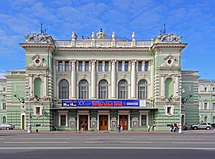 |
| Mariinsky Theatre, St Perersburg
Photo Wkipedia
|
"For Londoners used to Kenneth MacMillan’s masterful version for the Royal Ballet, this Romeo and Juliet seems flabbier and hammier — especially smugly arrogant Tybalt (Yuri Smekalov), seemingly modelled on Prince Charming from Shrek, and Vladimir Ponomarev’s theatrical Lord Capulet (even his eyebrows are up to something dastardly)."Well that may be how Londoners see it but for this Northern lass Tuesday's performance of Romeo and Juliet by the very company that had created the ballet was reet gradely. Xander Parish who danced Romeo ought to know what that commendation means for he was born in God's own county. For those who weren't. here's a definition and etymology.
I am a bit of a connoisseuse of Romeo and Juliet having seen English National's, Scottish Ballet's and Ballet Cymru's in a little over a year. I also know the Royal Ballet's very well. Indeed, I have actually seen Seymour and Fonteyn dance Juliet. In my humble, provincial opinion the Mariinsky's version towers above any I had previously seen.
I had expected a lot from this show. I had come to see Xander Parish whom I had last seen at the Yorkshire Ballet Summer School gala in York on my silver wedding anniversary 7 years ago ("We still have some of the best dancers in Yorkshire" 20 July 2014). Even though he and his sister were very young they impressed me with their athleticism and grace Xander Parish displayed those same qualities yesterday. That alone would have been enough to justify a 440 mile round trip at the height of summer with the motorways in a mess but there were two others who stood out.
First, Viktoria Tereshkina who danced Juliet. Even more than Parish, she was the star of the show. I was bowled over by her from her first few playful steps with her nurse. She is a powerful dancer with considerable elevation which she demonstrated frequently but she is also an accomplished actress projecting sensitivity and vulnerability. The crucial part of any production of Romeo and Juliet takes place in Juliet's bedroom. First, there is the newly weds' pas de deux. This is the most beautiful part of the ballet and it is on that sequence that the whole work hangs. Parish and Tereshkina were magnificent. After Romeo leaves her parents enter with Paris in tow with news that she is to marry Paris. So many emotions are unleashed in this poor young woman which she has to project in dance. Again, Tereshkina excelled. For the last 40 years Seymour had been my Juliet. From now on it will be Tereshkina
The other dancer who impressed me greatly was Kimin Kim. He danced Mercutio. He has a beautifully expressive face conveying every type of feeling. He interpreted the role brilliantly with boyish swagger as he provokes Tybalt (also danced well by Kamil Yangurazov). The sword fight with Tybalt was one of the most exciting and realistic I have ever seen on stage. "It's as if they are fighting with real swords" whispered my daughter manquée. Though we all knew how this fight would end how our hopes soared when Romeo seemed to separate the swordsmen and how they were dashed after Tybalt's sword punctured Mercutio's body. I could barely restrain a tear as Kim staggered around the stage rising to his feel, slumping, getting up again and eventually collapsing. This is one of the great death scenes in ballet. It stings Romeo into action overcoming temporarily even his love for Juliet. How we clapped and cheered as Kim took his curtain call at the end of Act II so relieved by the assurance that he was indeed alive.
There were sterling performances by Elena Bazhenova as Lady Capulet, Valeria Karpina as the nurse, Yuri Smekalov as Paris and Andrei Yakovlev who danced Friar Lawrence and Lord Montague. The whole company danced well but the cast is so long that it would be impossible to do justice to them all. The Martiinsky's orchestra conducted by Boris Gruzin played magnificently.
I need to say a few words about the sets and costumes. These were credited to Pyotr Williams whose biography in itself. Intrigued by the Welsh surname and Russian forename and found that he was the son of an American scientist who had become a Russian citizen in 1896. The very time that so many Russians were emigrating to the United States. Somehow this son of an American émigré survived Stalin's purges when so many other artists perished. The sets we saw on Tuesday must be reproductions of Williams's sets for the original 1940 performance. They were impressive particularly the opening scene of Verona with an estuary in the background, the Capulets' balcony and the burial ground. An interesting feature was the use of a second gold curtain which was no doubt intended to simulate the historic stage of the Mariinsky theatre.
"What's so special about the Russians?" my daughter manquée asked me when I invited her to the show. It is a question I had often asked myself. After all there are so many other fine companies around the world - not least our own Royal Ballet. Well after Tuesday's performance both my daughter manquée know the answer to that question. Despite revolution, purges, war and crisis the Mariinsky - the successor to the Imperial Russian Ballet - continues to set the standard to which everybody else aspires.

No comments:
Post a Comment